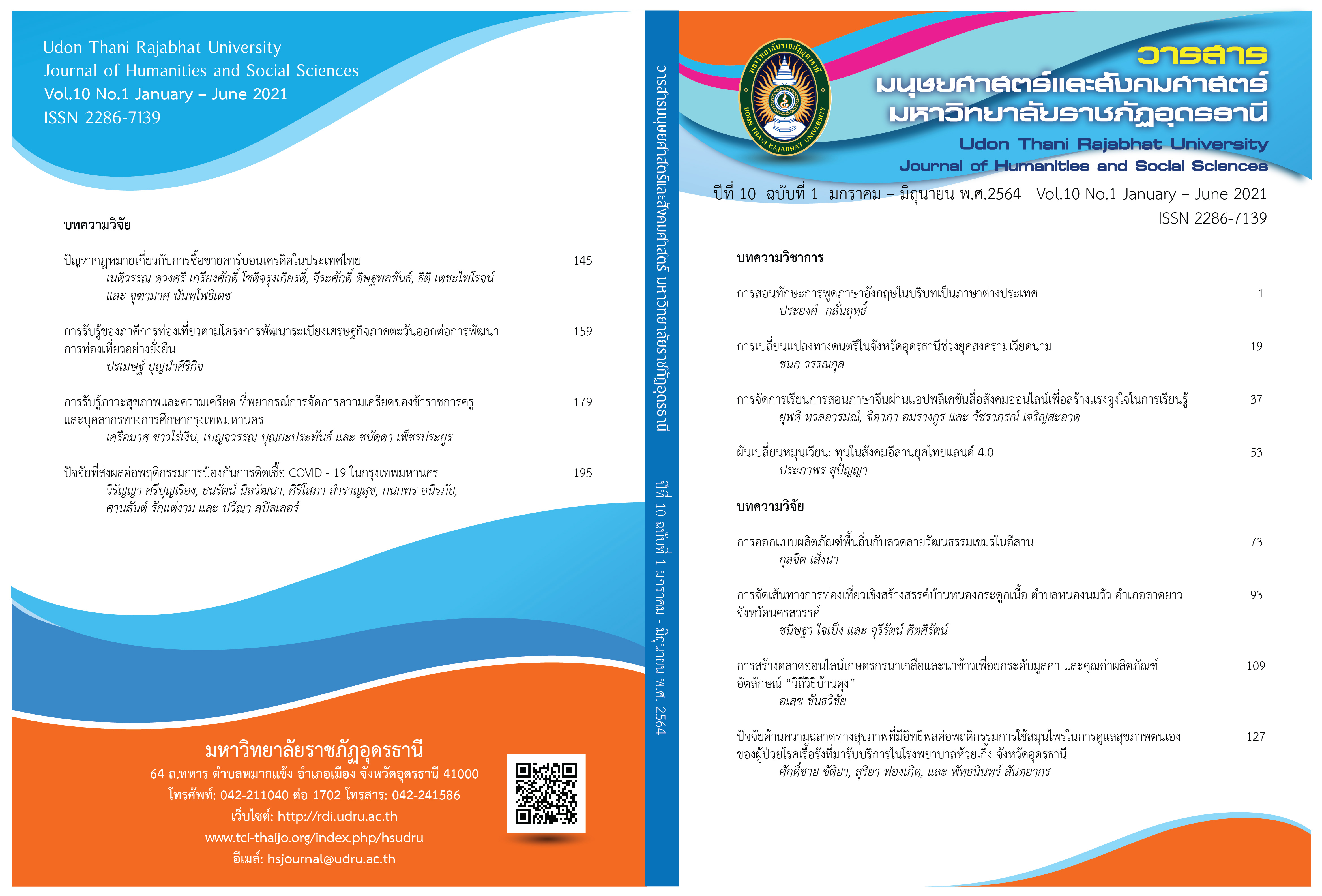การสอนทักษะการพูดภาษาอังกฤษในบริบทเป็นภาษาต่างประเทศ
Main Article Content
บทคัดย่อ
การพูดเป็นทักษะหนึ่งในทักษะทางภาษาอันได้แก่ การฟัง พูด อ่านและเขียน และมีบทบาทสำคัญอย่างยิ่งในการสื่อสารอย่างมีประสิทธิภาพ โดยเฉพาะการสอนภาษาอังกฤษ
ในบริบทเป็นภาษาต่างประเทศ ครูผู้สอนจำเป็นต้องมีความรู้ในการสอนทักษะการพูด โดยเฉพาะองค์ประกอบสำคัญในการสอนพูด ตลอดจนกิจกรรมการสอนพูดภายในห้องเรียน ซึ่งผู้สอนต้องสร้างโอกาสให้กับนักเรียนในการฝึกฝนการพูดภาษาอังกฤษโดยผ่านการมีปฏิสัมพันธ์ระหว่างผู้เรียนอันมีกิจกรรมคู่ (pair work) และกิจกรรมกลุ่ม (group work)
อันจะทำให้เกิดความมั่นใจในการพูดภาษาอังกฤษ
Article Details
เอกสารอ้างอิง
ประยงค์ กลั่นฤทธิ์. (2556). แนวการสอนภาษาอังกฤษในบริบทภาษาต่างประเทศ. กรุงเทพฯ: สำนักพิมพ์ศูนย์ส่งเสริมวิชาการ.
Bilasha, O., & Kwangsawad, T. (2004). Factors influencing Thai teachers’ abilities to adapt CLT intheir classrooms: A collaborative action research study. Thai TESOL Bulletin, 17, 1-10.
Brown, G., & Yule, G. (1999). Teaching the spoken language. Cambridge: Cambridge University Press.
Canale, M., & Swain, M. (1980). Theoretical bases of communicative approaches to second language teaching and testing. Applied Linguistics, 1(1), 1-47.
Chaney, A. L., & Burke, T. L. (1998). Teaching oral communication in grades K-8. Boston: Allyn & Bacon.
Davis, C. (2020). Spot The Difference: How Many Can You Find?. Retrieved December 23, 2020, from https://www.thedelite.com>spot-th-difference
Davies, P., & Pearse, E. (2000). Success in English Teaching: A Complete Introduction to Teaching English at Secondary School Level and Above. Oxford: Oxford University Press.
Foley, J. (2005). English in Thailand. RELC, 36(2), 223-234.
Fotos, S. (2002). Structured-based interactive tasks for the EFL grammar learner. In E. Hinkel, & S. Fotos (Eds.), New perspectives on grammar teaching in second language classrooms (pp. 135-154). Mahwah, NJ: Lawrence Erlbaum.
Goh, C. C., & Burns, A. (2012). Teaching speaking. Cambridge: Cambridge University Press.
Harmer, J. (2001). The practice of English teaching. 6th ed. Harlowe: Pearson Education Limited.
Hymes, D. (1972). On Communicative Competence. In J. Pride, & J. Holmes (Eds.), Sociolinguistics (pp. 269-285). Harmondsworth: Penguin Books.
Khamkhien, A. (2010). Uncovering Factors Contributing to Thai University Students’ Development of Oral Proficiency. ICERI2010 Proceedings, 2010-IATED, pp. 1740-1749.
Larsen-Freeman, D. (2002). Language acquisition and language use from a chaos. Language acquisition and language socialization: Ecological perspectives, 33.
Littlewood, W. (1981). Communicative Language Teaching. Cambridge: Cambridge University Press.
Nunan, D. (2003). Practical English language teaching. New York: McGraw-Hill.
Richards, J. C. (2006). Communicative Language Teaching Today. Cambridge: Cambridge University press.
Richards, J. C., & Renandya, W. A. (2002). Methodology in language teaching. Cambridge: Cambridge University Press.
Riggenbach, H., & Lazaraton, A. (1991). Promoting oral communication skills. In M. Celce-Murcia (Ed.), Teaching English as a second or foreign language (2nd ed.) (pp. 125-136). Boston: Heinle & Heinle.
Saengboon, S. (2004). Second language acquisition (SLA) and English language teaching (ELT). PASAA, 35(1), 11-34.
Savignon, S. J. (1983). Communicative competence: Theory and classroom practice. Massachusetts: Addison-Wesley.
Shumin, K. (2002). Factors to consider: Developing adult EFL students’ speaking abilities. Methodology in language teaching: An anthology of current practice, 12, 204-211.
Ur, P. (1998). A course in language teaching. Cambridge: Cambridge University Press.
Trent, J. (2009). Enhancing Oral Participation across the Curriculum: Some Lessons from the EAP Classroom. Asian EFL Journal, 11, 256-270.
Willis, J. (1996). A framework for task-based learning. Edinburgh: Longman.
Yunibandhu, R. (2004). Problems faced by Thai students making the transition from the Thai school system to the international school system. Master thesis, Chulalongkorn University.


